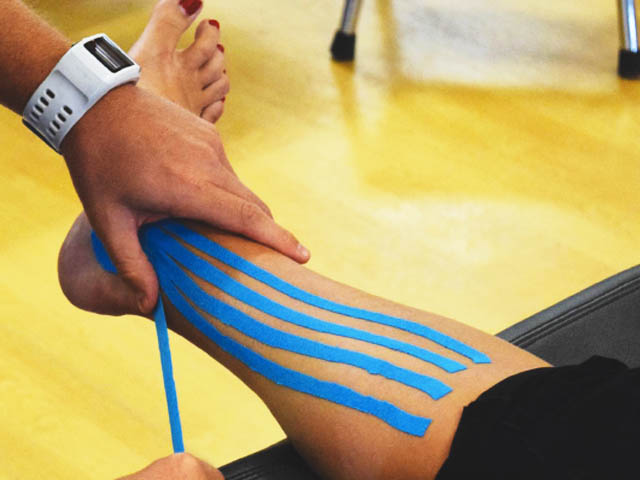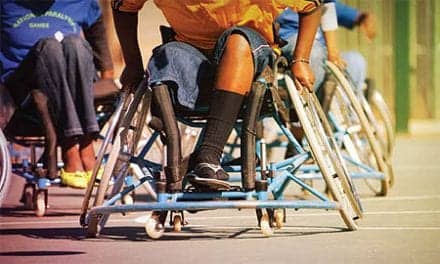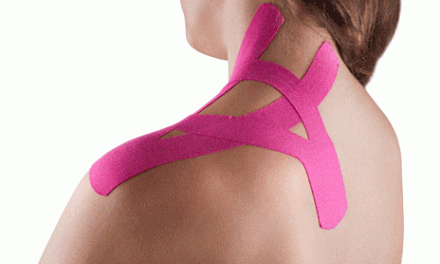The great debate on athletic taping has gained popularity over the years. Look around and you will see Olympic and professional athletes decorated in colorful tape. It has almost become a fashion statement instead of a performance enhancement. What is the reason for all the taping? Some athletes claim taping to be a miraculous cure. They believe their performance will suffer without it. Others claim that taping is no more than an expensive placebo effect. Let’s look to the research to understand the true effect of taping and uncover the mystery.
Use of Athletic Taping
Athletic taping has been used as a means to give stability to parts of the body that are overstressed from poor posture or muscle tightness. Taping is commonly used on the ankle to gain stability in the athletic population to better control ankle mobility. While it has been shown to help control excessive motion, taping in the ankle has also been shown to not give support for extended periods. As the athlete continues to move, the tension of the tape wears down and the effects become more minimal. The proprioceptive feedback of taping can temporarily allow athletes to be more efficient in their movement patterns. Providing tactile feedback for improved positioning lets the athlete move through pain while they are dealing with an injury. Pain-free and safe movement promotes tissue healing and muscle reeducation. This is a huge advantage to encourage early movement while healing is taking place. A display of this tactile feedback is commonly used in dealing with shoulder impingement issues. Positioning the tape in the acute phase to help address proper glenohumeral motion and control at the scapulothoracic joint can allow for more effective motion in the healing stages. In an impingement scenario, the greatest cause of the rotator cuff or bicep tendon impinging on the subacromial arch is poor control of the scapular stabilizers due to either mobility limitations or strength imbalances. After 90 degrees of shoulder abduction, the scapula and humerus work at a 1:1 ratio. If too much activation of the upper trap results in excessive scapular elevation, the tendons attaching to the humerus will pinch against the joint. By positioning tape to help control the motion of the scapula, it may help reeducate the body to work more efficiently and minimize the impingement while the tissues heal. This will allow time for the therapist to use skilled interventions to address whatever strength or mobility deficits are causing the impingement in the first place.
All this being said, taping should not be used as a mask over pain. It is not a tool to cover up pain to allow the athlete to push through an event or training session, while in the long run causing increased damage to the involved tissue or surrounding tissues. Safe and efficient motion and strength should always be the greatest factor to consider when an athlete is returning to full function. Again, using your assessment skills and understanding the properties of tissue healing are crucial to quality patient care and healing. Knowing your patient’s functional limitations and impairments by using skilled care will allow you to determine which movements are safe and appropriate for any stage of therapeutic intervention whether tape is being used or not. Understanding the mechanics of any given movement in relation to the patient’s limitations will help prepare the patient for safe and effective transition into prior level of function. If you choose to tape patients, get the proper training so you understand the rationale behind each taping technique. As with any treatment tool and technique you use, educating yourself properly will allow you to have the best understanding of how and when to utilize a specific approach.
Now, what about the healthy, noninjured athlete? Can taping be beneficial to them as a way to enhance performance or strength? Research says the tactile input of taping is not strong enough to control power in healthy athletes. When applied to healthy athletes, it does not inhibit or enhance muscle strength. So, for noninjured athletes, it is only your professional expertise that will improve their performance and strength, not an external tape. If a higher level athlete comes seeking your guidance regarding injury prevention or becoming an athlete, it is your job as a professional to perform a full functional assessment on the individual to best understand their goals and needs. Once you have a full understanding of the individual’s strength and mobility in all three planes as this relates to their sport, you will be able to develop the best interventions for their needs as well as educate them about the pros and cons of a taping protocol or any other treatment you see fit. RM
Tracy Hill, PT, DPT, CSCS, FAFS, graduated from Northern Arizona University in 2006 with a Doctorate in Physical Therapy and currently works at Spooner Physical Therapy in Phoenix, Ariz. Hill underwent a 10-month Fellowship in Applied Functional Science in 2010 where she was able to better assess a patient functionally in all three planes of motion and integrate the body working together as a whole. For more information, contact [email protected].






